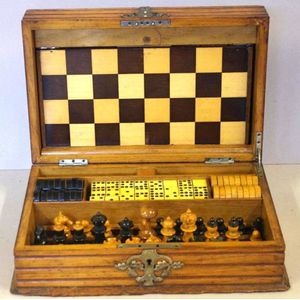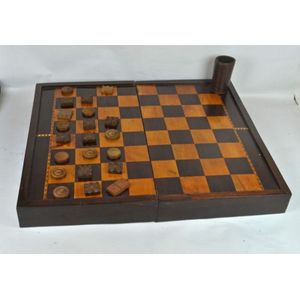Victorian Games Compendium with Chess and More
You must be a subscriber, and be logged in to view price and dealer details.
Subscribe Now to view actual auction price for this item
When you subscribe, you have the option of setting the currency in which to display prices to $Au, $US, $NZ or Stg.
- Ebony - Ebony is a close grained timber, black in colour. It has a fine texture which can be polished to a high gloss, making it suitable for venereering, inlay and stringing and its use as solid timber is resticted to small decorative items and ornamental decoration, such as chess pieces and musical instrument parts. The term "ebonised" means "faux ebony", timber that has been darkened during the polishing process to resemble ebony.
- Victorian Period - The Victorian period of furniture and decorative arts design covers the reign of Queen Victoria from 1837 to 1901. There was not one dominant style of furniture in the Victorian period. Designers used and modified many historical styles such as Gothic, Tudor, Elizabethan, English Rococo, Neoclassical and others, although use of some styles, such as English Rococo and Gothic tended to dominate the furniture manufacture of the period.
The Victorian period was preceded by the Regency and William IV periods, and followed by the Edwardian period, named for Edward VII (1841 ? 1910) who was King of the United Kingdom and the British Dominions and Emperor of India for the brief period from 1901 until his death in 1910. - Ivory - Ivory is a hard white material that comes from the tusks of elephants, mammoth, walrus and boar, or from the teeth of hippopotamus and whales. The ivory from the African elephant is the most prized source of ivory. Although the mammoth is extinct, tusks are still being unearthed in Russia and offered for sale.
Ivory has been used since the earliest times as a material for sculpture of small items, both in Europe and the east, principally China and Japan.
In Asia ivory has been carved for netsuke, seals, okimono, card cases, fan supports, animals and other figures and even as carved tusks.
In the last 200 years in Europe ivory has been used to carve figures, for elaborate tankards, snuff boxes, cane handles, embroidery and sewing accessories, in jewellery and as inlay on furniture. Its more practical uses include being used for billiard balls, buttons, and a veneers on the top of piano keys.
The use and trade of elephant ivory have become controversial because they have contributed to Due to the decline in elephant populations because of the trade in ivory, the Asian elephant was placed on Appendix One of the Convention on International Trade in Endangered Species (CITES), in 1975, and in January 1990, the African elephant was similarly listed. Under Appendix One, international trade in Asian or African elephant ivory between member countries is forbidden. Unlike trade in elephant tusks, trade in mammoth tusks is legal.
Since the invention of plastics, there have been many attempts to create an artificial ivory - Boxwood - Boxwood is a hard, yellow coloured, close grained timber. In the 19th century it was often used for inlays, especially stringing, because of its contrasting colour to the darker timbers of the carcase. Stringing is the inlay of a narrow strip of veneer of a lighter colour, such as boxwood along or close to the edges of an object that has been veneered in a darker timber such as mahogany.
Because of its fine grain and resistnce to splitting or chipping it has also been used for treen, turnings, carvings and other small wooden items, such as chess pieces. - Compendium - A compendium is usually a wooden box that has several compartments and drawers for storing the various items. A stationery compendium would be used for storing and organizing various personal or business items including documents, business cards, passports, and other items that need to be organized and easily accessible. It is typically a wooden box t
A compendium for correspondence would usually have pockets for holding different sizes of envelopes, and sometimes may have a built-in address book or a calendar. It can also have a pen loop or holder, and sometimes a calculator.A compendium for games would usually have pockets for holding game pieces, cards and sometimes rule books. It can also have a space for a chess or checkers board.A sewing compendium would have compartments for thimbles, bobbins, needles etc.
This item has been included into following indexes:
Visually similar items

Antique Continental games box, with ornate metal fittings, contains complete Chess set with board, dominos, draughts & dice, width 32 cm, diameter 21 cm, height 12 cm approx.

A Victorian rosewood & satinwood chess / backgammon board late 19th century with some backgammon playing pieces 46 x 54.2 cm (playing surface)

Victorian jewellery box and cover of deep rectangular form, the cover carved with a mother of pearl panel displaying three putto, surrounded by silver acanthus and scroll work, opening to fitted interior

A vintage ivory travelling chess set, box folded: 6 x 30 x 15. Provenance: The collection of the late Dr Thomas James Valentine
